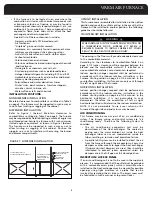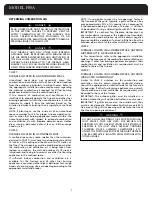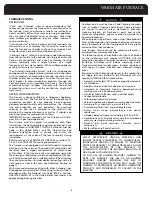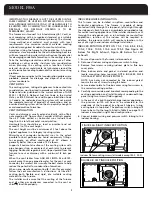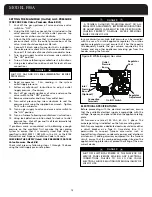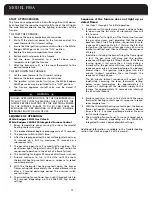
8
WARM AIR FURNACE
WARNING
SELECT APPROPRIATE VENTING MATERIALS AND
ENSURE PROPER CLEARANCES TO COMBUSTIBLES.
INADEQUATE VENTING OR FAILURE TO MAINTAIN
PROPER CLEARANCES TO COMBUSTIBLES MAY ALLOW
THE ACCUMULATION OF THE PRODUCTS OF
COMBUSTION WITHIN THE BUILDING RESULTING IN
FIRE, NAUSEA, OR ASPHYXIATION.
DO NOT USE AN UNLINED MASONRY CHIMNEY TO
VENT THIS FURNACE. THE USE OF AN UNLINED
MASONRY CHIMNEY INCREASES THE RISK OF
CONDENSATE FORMATION, WHICH MAY CAUSE THE
CHIMNEY TO DETERIORATE, ALLOWING COMBUSTION
PRODUCTS AND CONDENSATE TO COLLECT IN THE
BUILDING.
FURNACE VENTING
DEFINITIONS
"Vent" and "Chimney" refer to open passageways that
convey vent gases from the furnace, or its vent connector, to
the outside. Vents and chimneys usually run vertically or
nearly vertically. When they serve only one gas appliance,
they are called "dedicated" vents or chimneys. When they
serve multiple gas appliances, they are called "common"
vents or chimneys.
"Vent Connector" refers to a pipe or duct that connects the
furnace to a vent or chimney. Vent connectors usually run
from the furnace’s vent collar to the vent or chimney. Vent
connectors may have vertical and horizontal runs.
"Venting System" refers to a continuous open passageway
from the vent collar to the outside. Venting systems usually
have a vent connector(s) and a vent or chimney. Venting
systems commonly serve a single furnace, or a single
furnace and a hot water heater. Other multiple appliance
venting systems are less common.
"Fan Assisted Combustion System" refers to an appliance
equipped with an integral mechanical means to either draw
or force products of combustion through the combustion
chamber and/or heat exchanger. This series furnace uses a
draft inducer to draw combustion products through the
heat exchanger and is considered to have a fan assisted
combustion system. Category I furnaces with fan assisted
combustion systems must not be vented into single wall
metal vents.
DESIGN CONSIDERATIONS
The furnace is design certified as a Category I appliance,
which means that the furnace relies on the buoyancy of
combustion products to vent properly. Since buoyancy
decreases proportionately with temperature, the chimney
size and properties are very important. An oversized
chimney, or one that is exposed to the cold will not
maintain the required buoyancy as well as it should, and
may allow excessive condensation to form.
IMPORTANT: Do not common vent the furnace with Cate-
gory III or IV gas-fired appliances.
The furnace must be vented in accordance with these
instructions, the Venting Tables and rules published in the
current editions of ANSI Z223.1 / NFPA 54, National Fuel Gas
Code in the United States, or B149, Natural Gas and
Propane Installation Code in Canada, and within the
requirements of the codes of the local authority having
jurisdiction.
Refer to section 5.3 of ANSI Z2213.1/NFPA 54 or sections 7.2,
7.3 or 7.4 of CSA B149 for venting requirements.
The furnace is not equipped with a draft hood to introduce
dilution air to the chimney. The products of combustion will
therefore have a higher concentration of water vapor
within them. If the furnace is the only appliance served by
the chimney, a tiled masonry chimney, regardless of tile size,
must not be used without a suitably sized certified chimney
liner and termination. Consider dedicated venting with a B
Vent used as a liner in this case. See Dedicated Venting on
page 11.
Multistory and common venting with other Category I gas
fired appliances is permitted. The venting system must be in
accordance with the National Gas Code, B149 in Canada,
ANSI Z223.1/NFPA 54 in the United States, local codes, and
approved engineering practices.
CAUTION
Combustion air must be free of acid forming chemicals
such as sulphur, fluorine and chlorine. These elements
are found in aerosol sprays, detergents, bleaches,
cleaning solvents, air fresheners, paint and varnish
removers, refrigerants, and many other commercial and
household products.
When burned in a gas flame, vapors from these products
form acid compounds. Acid compounds increase the dew
point temperature of the flue products and are highly
corrosive after they condense.
Any furnace failure caused by corrosive elements is
excluded from warranty coverage.
The following types of installation sites (but not limited
to the following) will require OUTDOOR AIR for
combustion because of chemical exposures: commercial
buildings, buildings with indoor swimming pools,
furnaces installed in laundry rooms, furnaces in hobby or
craft rooms, furnaces installed near chemical storage
areas.
Exposure to the following substances in the combustion
air supply (but not limited to the following) will also
require OUTDOOR AIR for combustion:
• Aerosols, particularly CFC based or propelled aerosols
• Air fresheners
• Airplane Glue and similar adhesives and cements
• Ammonia, as commonly found in permanent wave
solutions used in hair dressing salons
• Antistatic fabric softeners used in clothes dryers
• Carbon tetrachloride
• Chlorinated cleaners and waxes
• Chlorine and bromine based swimming pool chemicals
• Deicing salts or chemicals, e.g. rock salt, etc.
• Dry cleaning fluids such as perchloroethylene
• Fumes from curing polyurethane and similar
substances
• Halogen based refrigerants including R-12 and R-22
• Hydrochloric acid, muriatic acid and other acid based
masonry washing and curing materials
• Printer’s inks, paint removers, varnishes, varsol,
toluene, etc.
• Water softener salt and chemicals
Summary of Contents for F80A
Page 24: ...23 MODEL F80A 50V51 250...





